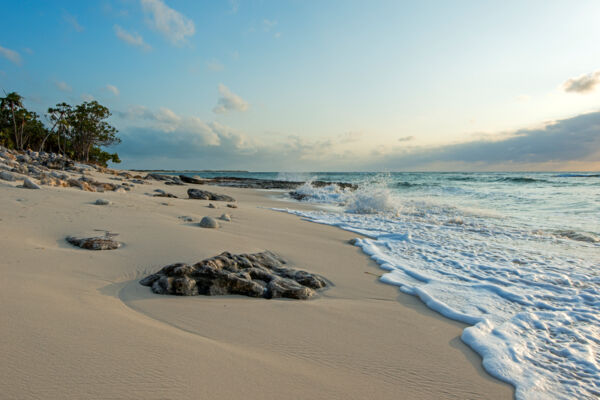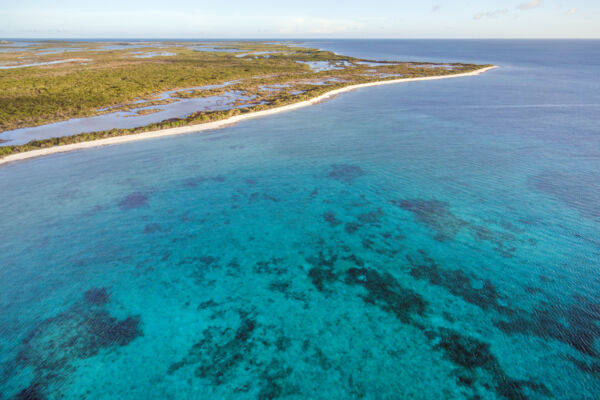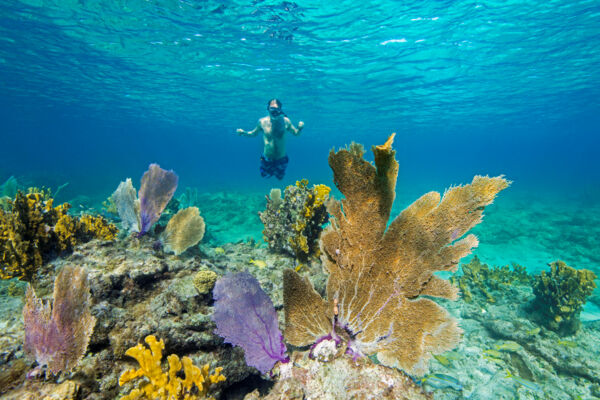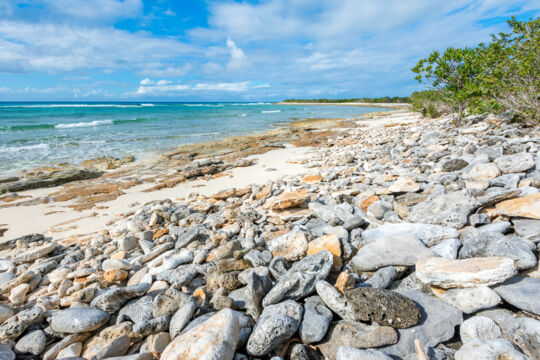Flamingo Creek Bay Providenciales

Flamingo Creek Bay is a secluded beach and coastline in the Frenchman's Creek and Pigeon Pond Nature Reserve. It is located on the west coast of Providenciales. The beach is remote, yet offers a beautiful setting, some of the best shore snorkeling on the island, and a small reef break that is one of the few surfing spots easily accessible from the beach.
Flamingo Creek Bay and the Frenchman’s Creek and Pigeon Pond Nature Reserve is one of the finest areas on Providenciales for birdwatching. A tidal creek runs parallel with the beach behind the coastal dune, and—as the area’s name suggests—flamingos and other large wading birds can often be seen in the waterway. The creek is part of an extensive tidal system, which has a connection through dense red mangrove forests to the primary channels in Frenchman’s Creek.
Flamingo Creek Bay is accessed by a rough 2.2-mile (3.5 km) track, which leads off of the road to Amanyara resort. Several sections of the track, notably the entry, are quite rough. A high-clearance vehicle is advised.

From the beach where the access road meets the ocean, the exclusive Amanyara resort can be seen to the north and Wiley Cut can be seen to the south. The ocean fronting Flamingo Creek Bay is part of the Northwest Point Marine National Park, and the southern boundaries of the national park are located just south of Wiley Cut.
Flamingo Creek Bay, Malcolm’s Roadstead, and the inland plains and valleys in the region have been used by many different peoples throughout history, including the pre-Columbian Lucayans and possibly pirates. Various feature names reflect this heritage. Indian Hill, located on the northern edges of the area, was referenced as a Taíno site by archeologist Theodore de Booy in the early 1900s. Two sheltered locations on Flamingo Creek Bay—Sam Bay and Simeon Rigby Hole—likely refer to sisal planters or wreck salvagers who may have inhabited the area in the post-Loyalist period of Turks and Caicos history.
Snorkeling Reefs

Flamingo Creek Bay offers some of the finest beach snorkeling on Providenciales, with two beautiful reefs located near the coast. Under typical conditions, the ocean is calm near the reefs, as the coast is on the lee side of Providenciales.
The northern reef, which is reminiscent of much of the shallow portions of the Caicos Barrier Reef, offers lush purple and yellow sea fan beds and gullies that teem with parrotfish, goatfish, yellowtail snapper, squirrelfish, blue tangs, and more.
The southern reef off Flamingo Creek Bay, while nearby, is surprisingly different. This reef is denser with more complex hard coral growth, including elkhorn corals. Sea sponges are also common, which is unusual for a shore reef.
The interior bay at Flamingo Creek Bay also has perhaps the highest density of long-spined sea urchins of any location near Providenciales.
Wiley Cut, which is a passage through the barrier reef, is found off the southern end of Flamingo Creek Bay. This passage is a route used by local scuba diving and charter boats, and is also an exceptional snorkeling site. However, due to the distance offshore and potential vessel traffic, it's not advisable to swim out to Wiley Cut from the beach.
Wetlands and Tidal Creek

A unique feature of Flamingo Creek Bay (and where the coast gets its name) is the long tidal pond system that follows the beach inland a short distance. This scenic waterway often supports a large number of birds, including the Caribbean flamingo, herons, egrets, ducks, stilts, sanderlings, plovers, and more.
This tidal creek is one of the more unique wetlands on Providenciales, as it supports several isolated bodies of water separated by red mangrove forest. The shallowest section and the peak extent of the tidal system is adjacent to the track access to Flamingo Creek Bay. The mollusks and crustaceans that thrive in the mud and dunes are important food sources for the wading birds.
Getting to Flamingo Creek Bay

Flamingo Creek Bay is located on the remote western coast of Providenciales inside the Frenchman’s Creek and Pigeon Pond Nature Reserve. The primary access to the beach is via a track that leads from the entry road to Amanyara Resort found off of Malcolm’s Road, which is the unpaved road that leads to Malcolm’s Road Beach.
The 2.2-mile (3.5 km) track to Flamingo Creek Bay is rough, particularly at the beginning. A high-clearance vehicle is recommended due to loose rocks. After heavy rains, a portion in the center of the track may have standing water, which can reach maximum depths of about 30 inches (76 cm). Deep, flooded road conditions are typically only present for about 7–14 days per year, and often coincide with the later Atlantic hurricane season in September, October, and November.



